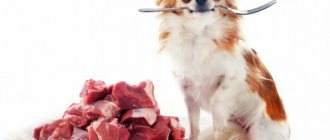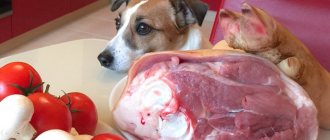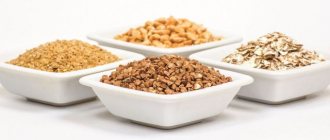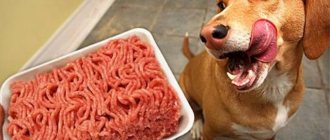Can dogs be given raw meat? The answer to this question is very controversial. There are as many supporters of such a feeding system as there are opponents. Arguments claiming that unprocessed meat has undoubted benefits sound very convincing. As well as those who say that raw meat is potentially harmful to a pet’s health. To understand which meat better satisfies the need for nutritious food, and to properly organize balanced feeding for your pet, you need to understand the basic physiology of the dog’s body.
The benefits and harms of meat for dogs
Meat should make up the majority of a dog's diet. From it the animal receives the maximum of substances necessary for life, which contribute to:
- replenishing the body with energy;
- strengthening the skeleton;
- building muscle mass;
- stable functioning of the hematopoietic system;
- improving the quality of coat and skin condition;
- general strengthening of the immune system.
Expert opinion
Kuzmenko Olga Olegovna
Information about the expert
Ask a Question
You should choose pulp of low-fat varieties. The fatty product is difficult to digest and stimulates the occurrence of diseases of the digestive system.
The benefits of different types of meat
- Pork. Not recommended for feeding puppies and pet dogs prone to obesity. Its lean parts are suitable for large breeds kept in open-type enclosures. The best time for such complementary feeding is winter, when serious energy replenishment is required.
- Beef. The best solution for the animal in terms of benefit and cost. Rich in organic iron, it does not cause allergic reactions. And its fat maintains energy balance in the body. It is best to start feeding puppies with this meat. Moreover, mature beef contains significantly more useful substances than young veal.
- Chicken. A controversial product because it often causes allergies. At the same time, it is a source of easily digestible protein.
- Rabbit meat. An excellent source of highly digestible protein. Allergies from its use occur extremely rarely. Used when necessary for dietary nutrition.
- Horse meat and lamb. Low-fat product that does not cause allergies. Rich in B vitamins. Better absorbed than beef.
- Offal. They cannot replace meat in terms of nutritional value, but they also have valuable properties. For example, beef tripe contains iron, phosphorus, and zinc. In its raw form, it retains particles of digestive enzymes. They help the dog's intestines cope with plant fiber. And the liver contains iron and folic acid, which is important for the body. Its deficiency results in pregnancy pathologies, inflammation of the mucous membranes and anemia.
Possible harm from meat products
Despite the benefits of meat, it also has negative effects:
- Any raw product can become a source of infection. You cannot feed the carcasses of dead animals, because the cause of death is not hunger or old age, but infectious diseases.
- Kidneys and liver require special preparation before use. They accumulate many toxins, naturally cleansing the animal’s body. They must be soaked and then scalded with boiling water.
- Chicken often contains growth hormones and all sorts of dietary supplements. Therefore, it can cause allergies in dogs. It can also become a source of salmonella infection.
- The flesh of wild animals can contain worm eggs and viruses of severe infections. It can only be fed boiled.
Types of red meat
You must understand that not all types of meat are suitable for feeding your pet. The dog can be given commercially bred beef, lamb, horse meat and rabbit meat.
What about pork? There is a lot of controversy about including it in the diet.
Many claim that pork meat contains a large number of worms, as well as various hidden viruses, so we advise you to treat it with caution.
We can definitely say that it should be given to your dog only if you are confident in the supplier. We strongly do not recommend taking meat from the so-called backyard slaughter, as well as meat from wild animals obtained by hunters, since you do not receive any guarantee of the quality and safety of this product.
By choosing such suppliers, you greatly risk the health of your pet!
Is it possible to give your dog raw meat?
Which meat is better to give your dog raw or cooked? When asking this question, remember that your pet is a predator. It has been proven that:
- The fresh product contains a full range of substances important for the body.
- It is absorbed better because the dog’s digestive tract is adapted to digest raw fiber, like that of any predator.
- The body becomes satiated faster, and the portion size required is smaller.
- During the cooking process, meat decreases in volume, most of the nutrients are destroyed or remain in the water. But the broth itself does not have the same value for a dog as it does for a person.
Product purchased from official markets and stores is considered safe. It undergoes mandatory veterinary and sanitary control. If its freshness is not suspicious, you can safely feed it to your dog without heat treatment.
If a hunting dog goes outdoors with its owner, strictly prohibit it from eating wild animals. They can be infected with parasites and dangerous diseases.
To prevent the development of mastitis in a puppy, it is not recommended to feed raw meat in the first week after birth. Such foods can cause increased lactation. Newborn puppies are too weak to handle large volumes of milk.
From three weeks of age, you can give your dog raw meat, which is scraped frozen. It is served as a separate dish or mixed with porridge.
Features of dog digestion
Raw meat is the most natural product for dogs, provided by nature itself. The first argument in its favor is observing the dog while eating. Have you ever paid attention to how your pet eats? A dog's jaw is naturally designed to bite and gnaw, but is absolutely not suitable for thoroughly chewing food. If you give your dog a large piece of meat, he will tear off pieces and swallow them whole. The reason is that the animal's saliva does not contain enzymes, and the digestion process begins only in the stomach. The muscles of the stomach are quite strong, and the acidity is high, which helps soften the muscle fibers of the eaten meat and digest them.
Finely chopped meat or minced meat does not contain dense muscle tissue, entering the acidic environment of the stomach, it is digested almost instantly, leaving a large amount of gastric juice idle. At this point, indigestion occurs. Frequent feeding of ground meat can lead to gastritis and gastrointestinal problems.
Briefly about the main thing
- The dog is a carnivore, its digestive system is prepared by nature to feed on raw meat;
- The animal's menu can consist of both raw and cooked products;
- Cheese contains more protein, fat and carbohydrates. A smaller portion is required for complete saturation;
- You can use different types of meat products, observing the reaction of the animal’s body;
- Chicken and other birds are given boiled;
- Treat your pet to offal and raw tripe twice a week;
- The meat is cut into pieces, the bones are given only raw.
Variety of tastes: how to complement the menu
When thinking about diet, we must remember that a pet’s body is adapted to eating protein foods. Therefore, he will not be able to be healthy and active by eating mainly plant-based foods. However, you should not neglect additives to the main diet either.
By-products
Innards are considered a good alternative to beef or lamb tenderloin. By-products are introduced into the menu of puppies from the age of 5-6 months; they are suitable for feeding animals of all breeds and ages. Thanks to the wide variety of offal, you can choose the piece that your four-legged friend will like the most.
Dogs eat almost all types of offal. So, beef tripe is very useful for puppies and adult pets. And the nutritious udder is recommended to be used for feeding disease-depleted individuals.
The main requirement when choosing is the freshness of the raw materials. You should not offer offal more than 2-3 times a week; liver and lungs should be introduced especially carefully. These parts can cause food allergies and do not have much nutritional value.
Bones
Bones are included in a dog’s menu not for satiety, but for oral hygiene. Thanks to a solid treat, the animal successfully cleanses the teeth of yellow plaque and tartar.
In addition, food debris stuck between the incisors and molars is removed. This helps prevent the development of bacteria in the mouth. While chewing, the gums are massaged, which is a good prevention of periodontal disease and gingivitis.
However, not all bones are equally useful, and some are even dangerous. You should not offer raw chicken or pork tenderloins. Tubular bones can injure the gums, and sharp fragments can harm the esophagus. Beef haunches and cartilage are suitable for feeding. Moreover, the size of the bone should be proportionate to the pet itself.
Cereals
Cereals in the diet allow you to saturate the animal’s body with essential elements and carbohydrates, which promotes proper digestion and maintenance of activity. But not every cereal is equally good. Veterinarians consider buckwheat and rice to be the best options for feeding. Less commonly used are oatmeal, barley, wheat cereals and rolled oats. Corn and pearl barley porridge is poorly digestible, so it should not be cooked.
You should not change cereals on the menu too often so as not to cause digestive upset. However, it is recommended to add another type of cereal to your usual porridge to diversify your food.
Fruits and vegetables
Fresh vegetables and fruits contain substances and vitamins that have a positive effect on the digestive system of your pet. However, not all of them are equally safe. Moreover, a dog that is not accustomed to plant foods is unlikely to eat carrots or cucumbers.
In small quantities, vegetables and fruits are introduced into the menu of puppies from six months of age. Safe types of plant-based foods include:
- carrot;
- cucumbers;
- pumpkin;
- zucchini;
- celery;
- cauliflower;
- apples;
- pear;
- bananas.
After your four-legged friend has eaten any vegetable or fruit, you need to carefully monitor his body’s reaction. If food allergies, diarrhea or diarrhea occur, this ingredient will have to be abandoned. Vegetables can be given fresh or boiled, mixing them with porridge.
Sour milk and eggs
It is recommended to add chicken or quail eggs to mixtures with other foods no more than 2 times a week. Such protein is not very well absorbed and harms the digestive system if consumed frequently. The number of eggs that are added to a pet’s dish is influenced by the size of the individual. For example, a large representative can eat many pieces without much harm, but a small individual can eat one. In addition, eggs are a strong allergen.
Milk contains protein, which is easily digestible and has a good effect on health. However, this only happens if cottage cheese, kefir or cheese have low fat content. Fatty foods lead to indigestion and diarrhea. If the owner gives his pet yogurt, it should be natural, without added sugar or canned fruit.
How to give a raw product correctly to avoid trouble?
For the safety of your pet, you must adhere to the following rules:
- Raw meat should be scalded with boiling water before feeding. To improve the effect, it is recommended to chop it. Even if you bought it from a trusted place, you cannot exclude the possibility of pathogenic bacteria entering during transportation and storage. This serving method will also help if the dog refuses raw meat in its pure form.
- To kill possible parasites, it is enough to freeze it. Pre-divide into portions for easy use later. It is better to defrost in the refrigerator; you cannot use a microwave for this purpose.
- When on a raw food diet, carefully monitor your dog's health. Allergies, diarrhea, or parasite infection may occur.
- The bird carcass must be freed from bones. They can cause surgery or constipation, at best.
- Choose only low-fat cuts. Along with the muscle parts, a sufficient amount of healthy fat enters the pet’s body. Excess causes diarrhea, allergies and excessive stress on the kidneys and liver.
- You can’t feed meat with a “smell.” A spoiled product may be sold at a reduced price, but you should not skimp on your pet’s health.
Useful video on the topic: is it possible to give raw meat to a dog?
By-products
You can give your pet by-products obtained from healthy livestock, rabbits or poultry:
- lungs;
- liver;
- scar;
- udder;
- trim.
When preparing your diet, keep in mind that the nutritional value of these products, with the exception of liver, is 2 times lower than that of muscle fibers. They should make up no more than 50% of the protein diet. But adding them to the menu is useful not only to reduce its cost, but also to the health of the animals. Beef liver will provide the dog's body with well-absorbed folic acid and iron. Tripe is rich in zinc and contains enzymes that improve the absorption of plant foods. With the udder, the pet will receive iodine, potassium, potassium, calcium, sodium, vitamins B and P.
Daily ration
Meat should account for an average of 30-40% of the total food that the animal eats daily. When calculating the required amount, you should take into account the breed, gender, weight, temperament and lifestyle of the pet.
So, if a dog lives in an apartment and doesn’t run around much, 10-20 grams of meat per day per kilogram of weight may be enough for him. An active, energetic, athletic young dog or working animal (hunter, rescuer, etc.) needs more - up to 30 grams of meat per day per kilogram of its weight.
The norms for growing puppies have been increased, because they need a lot of microelements to form all body systems. In addition, at the age of about a year, most dogs are especially active and mobile, which means they need a complete protein diet.
The table below shows approximate values for pets of different breeds (in kilograms per day).
| Breeds | Puppy 6-12 months | Adult dog | Older dog (over 8 years old) |
| Small (an adult dog weighs less than 10 kg) | 0,5-1 | 0,4-0,8 | 0,3-0,8 |
| Medium (an adult dog weighs 10-25 kg) | 1-2 | 0,8-1,5 | 0,6-1 |
| Large (an adult animal weighs more than 25 kg) | 1,5-2,5 | 1-2 | 0,8-1,5 |
You can use the following formula for calculations: X * 2/100, where X is the weight of the dog. For example, if a dog weighs 30 kg, multiply this number by two, divide by one hundred and get 0.6 kg of meat per day.
The norm should be increased for a very active dog, for a weakened dog (for example, after an illness) or when fighting obesity (the number of fats and carbohydrates decreases, the percentage of proteins - meat increases). Then the formula will look like this: X*3/100. For example, if the dog weighs the same 30 kg, multiply by three, divide by one hundred and get 0.9 kg per day.
How to feed your dog correctly
The principles of proper nutrition for a pet include the following recommendations for feeding it:
- For good absorption of the food given to the dog, it is advisable to divide its daily volume into several feedings during the day: for adults this is 2 times a day, and for puppies - up to 6 times.
- A new type of meat is always introduced into the animal’s diet gradually, and the owner must carefully monitor any changes in the dog’s well-being and behavior. Undesirable side effects often manifest themselves in the form of disruption of digestive processes, deterioration of the skin and coat.
- When preparing food for your dog, it is better to cut the meat into large pieces that the animal will have to chew. This will help remove tartar and plaque from the surface of your dog’s teeth. Moreover, the soft consistency of minced meat does not allow it to linger in the stomach, which means that very soon the animal will feel hungry again.
- If after the next meal there is food left in the dog’s bowl, this is a reason to reduce the portion size.
- When feeding raw meat trimmings, routine deworming of the animal will be mandatory (the possibility of the presence of parasite eggs in the tissues cannot be ruled out).
- If the dog is fed natural and varied food, at least 6 hours should pass between meals. This will allow the animal to avoid overeating and better absorb the nutrients it receives.
Important! Before giving meat to small puppies (from one month), it is better to pour boiling water over it, regardless of how confident the owner is in the quality of the product. For the first time, the volume of new food should not exceed the size of a large pea, however, already in the first month its amount is increased to 100 g.
Meat feeding standards by weight
When composing a pet dog’s diet, its owner should always focus on the animal’s weight, because the larger it is, the more food the pet needs for full growth and development. Thus, the norms for calculating the daily volume of meat for representatives of medium breeds will be as follows:
- For an active adult - approximately 3-4% of the total body weight, that is, 400 g for a ten-kilogram dog.
- For inactive or elderly pets - 2–2.5% of total body weight or 250 g for a dog weighing 10 kg.
- For growing puppies - 6% of body weight, divided into 6 meals with equal intervals between food.
The norm of natural products shifts upward for representatives of large breeds, especially those leading an active lifestyle, pregnant and lactating females, and kennel dogs during the cold season (up to 800 g per day). You can limit the amount of meat provided in the following cases:
- keeping pets of miniature breeds;
- animals kept in an apartment with minimal physical activity;
- dogs suffering from kidney failure and diseases of the genitourinary system;
- animals prone to allergic manifestations, in particular due to excessive consumption of protein foods.
Important! Normally, the amount of meat and offal in a dog’s daily diet should be at least 2/3 of the total amount of food given to it.
What else should you include in your diet?
Meat is an important, but far from the only component of the proper diet of a domestic dog, especially since excessive protein consumption threatens poisoning. In addition to it, the same important components for health will be carbohydrates, fats and fiber, which are present in sufficient quantities in fish, eggs, cereals, dairy products, vegetables and fruits. Mixed feeding with natural products will provide the dog’s body with energy, strengthen the immune system and prevent problems in the digestive, cardiovascular and nervous systems.
Useful tips
You can feed your dog raw meat, but it is important to follow some rules:
- Cut into large pieces so your dog will have to tear and chew. This process will clean your teeth.
- The portion is calculated based on the age, weight, breed and well-being of the animal. For an apartment dog - 20 g per 1 kg, for an active young pet or a pet weakened by illness - 30 g per 1 kg of weight.
- It is recommended to divide the daily portion into two doses.
- You cannot replace your dog's protein diet with meat. It is also necessary to include low-fat fish and fermented milk products.
- If you don’t want to give the pulp raw, but want to retain more nutrients, cook it at the same time as the cereal. The porridge will quickly cook, and the meat will receive primary heat treatment without losing its beneficial elements.
Conclusion: giving dogs fresh meat is necessary. But do not forget about compliance with the rules and regulations for the safety of its use. Combine a variety of sources of animal protein, add cereals, seasonal vegetables and your pet will always be healthy and active.
How to give
A portion of raw meat is calculated based on the breed, weight, age and condition of the animal. Let's highlight the rules:
- It is advisable to give it in large pieces so that the dog has to tear and chew it, cleaning its teeth.
- Once purchased, they can be frozen to kill parasites. Then defrost it in portions in the refrigerator without using a microwave.
- Feeding frequency: twice a day.
- For an apartment dog, the portion is 20 grams per 1 kg of weight, for a weakened or active dog – 30 grams per 1 kg.
- If the dog does not eat raw meat, the owner will have to choose another type of food. You can try scalding it with boiling water.
- When eating a raw food diet, your dog may experience diarrhea, allergies, or parasite infestation. You need to strictly monitor the daily condition of your pet and take immediate action.
Remember that the dog’s diet should be varied; the owner will have to independently purchase and give the animal complexes of minerals and vitamins.
What's harmful?
Not everything in the world is equally useful. This axiom is also true for our little brothers. There are products that will not bring any benefit, and often cause great harm, causing, at best, an upset stomach, and at worst, serious diseases of the internal organs.
Unhealthy food:
- Pork . Too fatty and heavy for a dog's digestive system. Their ancestors have never encountered anything like this, which means their stomachs simply cannot digest this type of product and get what they need.
- Lard and pieces with fatty layers will also have an extremely negative effect on the absorption of nutrients.
- All kinds of chemical and vegetable substitutes , for example, soy.
- Sausage, frankfurters, sausages and other store-bought human “delicacies”. The animal eats them with pleasure, but they are made for people, taking into account their preferences. Such products contain salt and spices, which are extremely harmful. Specific processing methods and all kinds of chemical additives will also not add any benefit.
- Prepared for humans . Unless you are an opponent of spices and prefer to cook exclusively by steaming, do not share your dinner with your pet, even if he is actively begging. A piece from your plate will only harm your pet.
- Fried, baked, smoked or otherwise prepared meat is considered “dead” to the dog. The amino acids it needs have been destroyed, and protein will be poorly absorbed. But dried or dried pieces of beef without spices can be given out as a treat.











